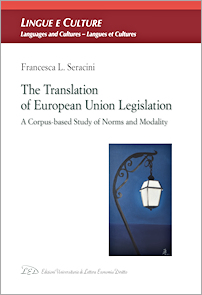
Francesca Seracini
THE TRANSLATION
OF EUROPEAN UNION LEGISLATION
A Corpus-based Study of Norms and Modality
ISBN 978-88-7916-928-8 - 15,5 x 22 cm - 2020 - pp. 192
This volume is a study into the norms that come into play in the translation of European Union legislation. With a focus on expressions of modality, the study adopts a corpus-based Descriptive Translation Studies approach to analyse the translation strategies used in a bilingual English/Italian parallel corpus of European Union legislation and identify the most frequent translational patterns. The book outlines the principles at the basis of the multilingual policy at the European Union and provides a detailed outline of the context in which the drafting and translation processes take place as a key to understanding the translational choices. The impact of sometimes contrasting factors such as the conventions of legal drafting at the European Union and those within the target culture, the principle of equal authenticity and the attention to the quality and readability of legislative texts is revealed in the analysis. Evidence in support of the theories concerning translation universals is also found and their implications for EU legal translation are discussed. The results lead to the formulation of several hypotheses as regards the norms governing the translation of EU legislative texts. The book also reflects on the impact that the translational choices have on the development of European Union legal language as an independent variety. This volume will be of interest to researchers and students in the fields of Legal Translation Studies and Linguistics, as well as practising translators.
Francesca L. Seracini, holds an MA in Foreign Languages and Literatures and a Ph.D. in Linguistic Sciences. She is a Postdoctoral Research Fellow at Università Cattolica del Sacro Cuore in Milan. Her research concerns legal language and translation, phraseology, corpus linguistics and professional communication. Her research is characterized by a methodological approach based on
discourse analysis integrated with quantitative investigation in the tradition of corpus
linguistics. Her publications include the volume Nuovi media e discorso politico.
I blog nelle elezioni presidenziali americane [New Media and Political Discourse.
Blogs in US Presidential Elections] (2014) and the journal article “Representation
of Knowledge about Opioids between Criminalization and Medicalization” (2020).

Preface
______
1.
1. Multilingualism at the European Union
1.1. Introduction – 1.2. European Union legal instruments – 1.3. Multilingualism at the European Union: legal principles – 1.3.1. Legal basis of multilingualism – 1.3.2. The principle of equal authenticity – 1.3.3. Legal harmonisation
2.
Drafting and translation of European Union legislation
2.1. Introduction – 2.2. Quality in European Union legislative texts – 2.2.1. From drafting to translation – 2.2.2. The role of the translators – 2.2.3. Translation tools – 2.3. European Union legal language and translation – 2.3.1. Main characteristics of EU legal language – 2.3.2. Clarity in EU legal texts – 2.3.3. The translation of EU legislation
3.
Theoretical framework and methodological considerations
3.1. Introduction – 3.2. Descriptive Translation Studies – 3.2.1. Basic theoretical concepts: a brief outline – 3.2.2. Norms in translation – 3.2.3. Corpus-Descriptive Translation Studies – 3.3. Universal features in translation – 3.4. The EURO-CoL and the UK-LAW corpora.
4.
Modality in legal discourse
4.1. Introduction – 4.2. Modality in legal language and translation
5.
Translational patterns for modality in the Euro-CoL corpus
5.1. Introduction – 5.2. Distribution of the expressions of modality in ENGLEX – 5.3. Shall – 5.3.1. Shall in the EURO-CoL corpus – 5.3.2. The translation of shall in the EURO-CoL corpus – 5.4. Should – 5.4.1. Should in the EURO-CoL corpus – 5.4.2. The translation of should in the EURO-CoL corpus – 5.5. May – 5.5.1. May in the EURO-CoL corpus – 5.5.2. The translation of may in the EURO-CoL corpus – 5.6. Must – 5.6.1. Must in the EURO-CoL corpus – 5.6.2. The translation of must in the EUROCoL corpus – 5.7. Can – 5.7.1. Can in the EURO-CoL corpus – 5.7.2. The translation of can in the EURO-CoL corpus – 5.8. Will – 5.8.1. Will in the EURO-CoL corpus – 5.8.2. The translation of will in the EURO-CoL corpus – 5.9. Be to – 5.9.1. Be to in the EURO-CoL corpus – 5.9.2. The translation of be to in the EURO-CoL corpus – 5.10. Discussion of results
6.
Concluding remarks
6.1. Three tendencies of translational behaviour and norms – 6.2. Evidence of translation universals – 6.3. Implications, limitations and future directions
Appendix 1
ENGLEX – Wordlist (Top 300 Words)
Appendix 2
ITALEX – Wordlist (Top 300 Words)
Appendix 3
ITALEX/LEGITALIA – Keyword List (Top 300 Words)
______
Lingue e Culture - Languages and Cultures - Langues et Cultures - ISSN 2234-9235
Collana diretta da Giovanni Gobber e Marisa Verna
Comitato scientifico: Thomas Austenfeld - Susan Conrad - Manuel Alvar Ezquerra - Françoise Gaillard - Roman Govorucho - Augusto Guarino - Juliane House - Georgy Akhillovich Levinton - Anthony Mollica - Michael Rossington - Nikola Roßbach - José Carlos Rovira Soler - William Sharpe - Thomas Travisano - Bart Van Den Bossche - Jakob Wüest




